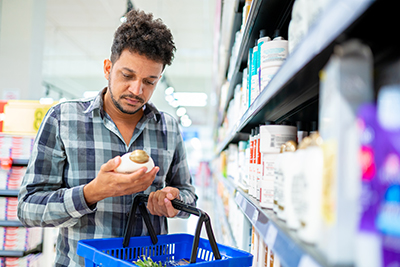By: Tom Duffy, Senior Advisor, Industry Relations, FMI

It wasn’t that long ago when most shoppers were a captive audience at the checkout stand, prone to scanning the rack while waiting and tossing in a pack of gum, a tube of lip balm, hair ties or maybe some batteries.
Of course, while such last-minute purchases are still commonplace at the front of the store, merchandising and payments have been pulled in all kinds of different directions in recent years. From the increasingly popular curbside pickup model to scan-and-go
technologies to home delivery, new ways of retailing have led to different approaches to encouraging impulse buys, including nonfood products.
At the heart of tactics for this era of retailing is a familiar driver, according to Liz Roche, chief data officer at Accelerate360, an omni-commerce sales, distribution and logistics, marketing
and media company headquartered in Atlanta. “We find that with impulse, the shopper is acting with emotion. They are not using the logical side of the brain,” she explains, adding that emotion is what spurs the quick decision to add something
unexpected to the cart. “Emotional thought is processed five times faster and reacted to 3,000 times faster. Being able to play to these emotions and to use strategies to incite that impulse is how we see retailers having success in this area.”
Although emotion often triggers a craving, sentiment can also propel a shopper to grab a nonfood item as an unplanned purchase at several points in the shopping journey.
Roche offers some tips for evoking feelings and turning them into surprise-and-delight sales:
Stay on trend.
FOMO, or the fear of missing out, is real. Retailers can use product selection and merchandising tools to tap into the innate desire to be “in” on a trend or to be part of an occasion or event. “When we analyze best-performing
programs, almost 70% of selections play into that feeling of FOMO. Whether it’s a dog toy, die-cast car or even birthday candles because you don’t want to miss out on a birthday event, there are ways to bring that to life in impulse,"
says Roche.
Create conditions that support emotional decision-making.
“We see it two ways. One is with complement-based merchandise, like coffee straws in the coffee aisle or wine openers in the wine aisle, and one is traffic-based, like finding a wine opener in the cheese case,” she says. “The best-performing
retailers leverage a combination of those two strategies.”
Tap into demand for stress relievers and rewards in an inflationary climate.
Roche points out that emotion also plays into a desire for small indulgences and self-care, especially during challenging times. In fact, she reports, some impulse products have been outpacing the market as of late. “That will continue to be important,
as folks feel like they can let go a bit to have some stress relief and a spark of joy,” Roche predicts.
What about breaking through the ecommerce hurdle for impulse purchases? Roche points out that shoppers can still feel an emotional pull in the digital space, if nonfoods impulse items are easy to find on the screen and digitally merchandised with other
related products.
As the nonfoods category continues to evolve, trading partners will invest in creative strategies to add to customers’ enjoyment through unique discovery experiences.
Learn more about strategies for lifting sales of nonfood products at the upcoming nonfoods event, June 13 – 15, 2023 in Arlington, VA. If you’re interested, contact me at tduffy@fmi.org.

 Industry Topics address your specific area of expertise with resources, reports, events and more.
Industry Topics address your specific area of expertise with resources, reports, events and more.
 Our Research covers consumer behavior and retail operation benchmarks so you can make informed business decisions.
Our Research covers consumer behavior and retail operation benchmarks so you can make informed business decisions.
 Events and Education including online and in-person help you advance your food retail career.
Events and Education including online and in-person help you advance your food retail career.
 Food Safety training, resources and guidance that help you create a company food safety culture.
Food Safety training, resources and guidance that help you create a company food safety culture.
 Government Affairs work — federal and state — on the latest food industry policy, regulatory and legislative issues.
Government Affairs work — federal and state — on the latest food industry policy, regulatory and legislative issues.
 Get Involved. From industry awards to newsletters and committees, these resources help you take advantage of your membership.
Get Involved. From industry awards to newsletters and committees, these resources help you take advantage of your membership.
 Best practices, guidance documents, infographics, signage and more for the food industry on the COVID-19 pandemic.
Best practices, guidance documents, infographics, signage and more for the food industry on the COVID-19 pandemic.
